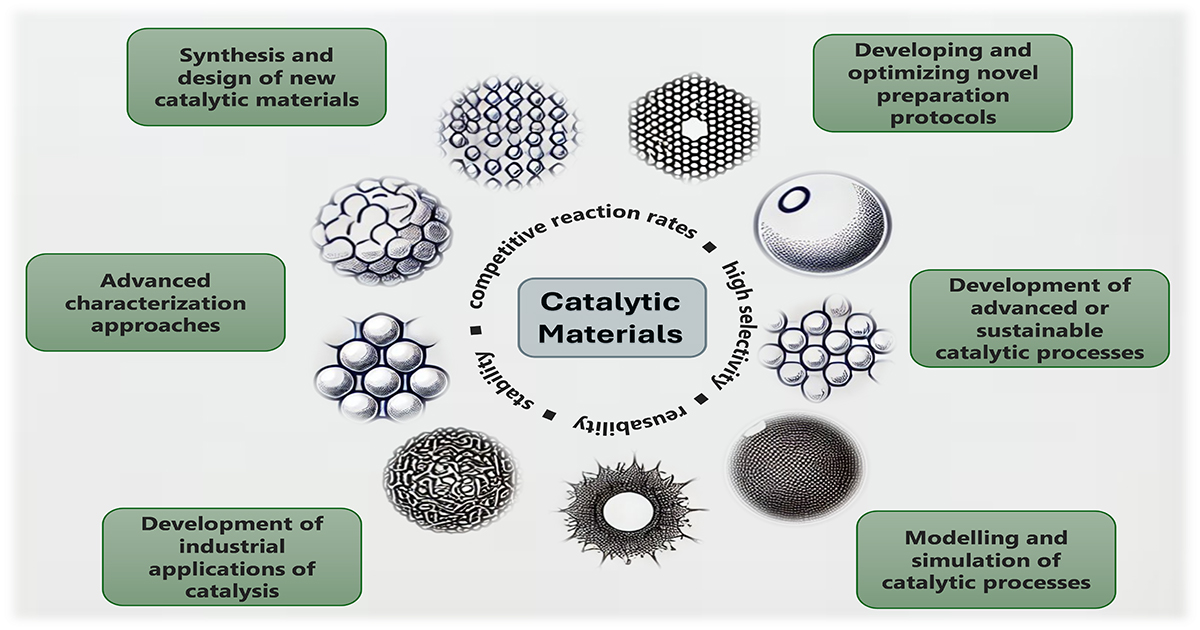- 4.0Impact Factor
- 7.6CiteScore
- 17 daysTime to First Decision
Exclusive Feature Papers in Catalytic Materials
This special issue belongs to the section “Catalytic Materials“.
Special Issue Information
Dear Colleagues,
The development of catalytic materials is one of the most active research areas in the field of catalysis. Catalytic materials must provide an adequate response in several aspects, including competitive reaction rates, high selectivity towards desired products, and appropriate levels of reusability and stability, among others.
Optimizing these parameters for each catalytic application requires appropriate research schemes that include the synthesis of novel materials, the development of new preparation methods or the optimization of existing ones, the development of advanced characterization schemes (in situ/operando), and the design of efficient reaction schemes and reactors.
In addition to a wide range of applications that most of the specialized literature defines as “traditional catalysis”, several novel schemes have been proposed in recent years. Technologies such as photocatalysis, electrocatalysis, microwave-assisted catalysis, and ultrasound-assisted catalysis, among other alternative schemes, have opened up new pathways and expanded the need for catalytic materials.
Moreover, combined energy schemes are also a relatively new approach that require a significant leap in terms of the development of catalytic materials. Photothermal/thermo-photocatalysis, electro-photocatalysis, or piezo-photocatalysis are just some examples that drive researchers to intensively develop new catalytic materials with optimized properties for specific applications.
This Special Issue aims to attract relevant articles related to all areas of catalytic materials. The research scope of this Special Issue includes, but is not limited to, the following:
- Synthesis and design of new catalytic materials;
- Developing and optimizing novel preparation protocols;
- Advanced characterization approaches;
- Development of advanced or sustainable catalytic processes;
- Development of industrial applications of catalysis;
- Modeling and simulation of catalytic processes.
These research lines represent just some examples of the broad spectrum of topics that can be addressed in the field of catalytic materials.
We invite researchers to contribute their findings and advancements to this Special Issue, with the aim of fostering knowledge exchange and promoting the development of innovative and sustainable catalytic materials and processes.
If you would like to submit papers to this Special Issue or have any questions, please contact the in-house editor, Ms. Rita Lin (rita.lin@mdpi.com).
Prof. Dr. Mario J. Muñoz Batista
Guest Editor
Manuscript Submission Information
Manuscripts should be submitted online at www.mdpi.com by registering and logging in to this website. Once you are registered, click here to go to the submission form. Manuscripts can be submitted until the deadline. All submissions that pass pre-check are peer-reviewed. Accepted papers will be published continuously in the journal (as soon as accepted) and will be listed together on the special issue website. Research articles, review articles as well as short communications are invited. For planned papers, a title and short abstract (about 250 words) can be sent to the Editorial Office for assessment.
Submitted manuscripts should not have been published previously, nor be under consideration for publication elsewhere (except conference proceedings papers). All manuscripts are thoroughly refereed through a single-blind peer-review process. A guide for authors and other relevant information for submission of manuscripts is available on the Instructions for Authors page. Catalysts is an international peer-reviewed open access monthly journal published by MDPI.
Please visit the Instructions for Authors page before submitting a manuscript. The Article Processing Charge (APC) for publication in this open access journal is 2200 CHF (Swiss Francs). Submitted papers should be well formatted and use good English. Authors may use MDPI's English editing service prior to publication or during author revisions.
Keywords
- new catalytic materials
- novel preparation methods
- characterization of catalysts
- sustainable catalytic processes
- industrial applications of catalysis

Benefits of Publishing in a Special Issue
- Ease of navigation: Grouping papers by topic helps scholars navigate broad scope journals more efficiently.
- Greater discoverability: Special Issues support the reach and impact of scientific research. Articles in Special Issues are more discoverable and cited more frequently.
- Expansion of research network: Special Issues facilitate connections among authors, fostering scientific collaborations.
- External promotion: Articles in Special Issues are often promoted through the journal's social media, increasing their visibility.
- e-Book format: Special Issues with more than 10 articles can be published as dedicated e-books, ensuring wide and rapid dissemination.

